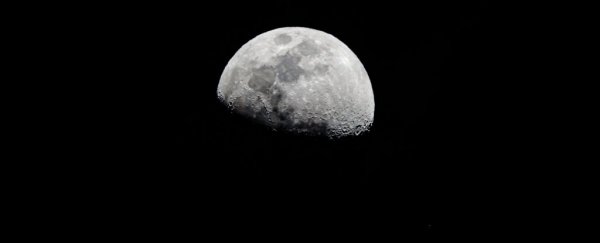There's not a lot, comparatively, going on at the Moon. There's dust. There's rock. There's basalt plains, the product of extensive volcanism over much of the Moon's history.
And, as we have recently discovered, there's water. Lots of water. Bound up in the lunar regolith. Trapped in volcanic glass. Possibly even in sheets of ice on or just below the surface, hiding in craters at the poles that lurk in permanent shadow, where it can't be sublimated by the heat of the Sun.
Where this water might have come from is still something of a mystery. But new research suggests an interesting source, a process we know has occurred on the Moon a lot in the past: volcanoes.
Planetary scientists have been wondering whether there would have been sufficient amounts of water molecules in the ancient Moon's volcanic outgassing to fall back down to the surface and form sheets of ice in permanent shadow. Now it seems that the answer is 'yes'.
"Our model suggests that [around] 41 percent of the total H2O mass erupted over this period could have condensed as ice in the polar regions, with thicknesses up to several hundreds of meters," wrote a team of researchers led by planetary scientist Andrew Wilcoski of the University of Colorado Boulder in their paper.
"Our work suggests that the volcanically active period of the early Moon would have been punctuated by short-lived, collisional atmospheres that enabled the efficient sequestration of large quantities of water ice at the poles and the temporary diurnal availability of water ice and vapor at all latitudes."
The Moon seems pretty serene these days, but once upon a time it was a hot mess. Those dark patches you see when you look at the full Moon are vast plains of volcanic rock, from a period of large-scale volcanic activity that may have began as early as 4.2 billion years ago, and lasted until about 1 billion years ago, with most of the activity occurring in the first two billion years or so of that time frame.
Tens of thousands of volcanoes spewed lava out onto the Moon, covering the surface with volcanic landscapes (for context, the most volcanic body currently in the Solar System is Jupiter's moon Io, which has over 400 known volcanoes).
In addition, those eruptions would have included humongous clouds of volcanic gases, mostly carbon monoxide and water vapor. These could have formed tenuous, transient atmospheres around the Moon that later dissipated into space. But, Wilcoski and his colleagues hypothesized, what if the water vapor didn't all dissipate in the solar wind; what if some of it settled like frost?
They conducted modeling, based on an average massive eruption rate of around once every 22,000 years. They then studied the rate at which the volcanic gases escaped into space, compared to how much condensed, froze, and settled on the lunar surface.
They found that, while the atmosphere persists – a timespan of about 1,000 years – roughly 15 percent of the water settles and forms a frost on the lunar nightside, around 8.2 quadrillion kilograms (18 quadrillion pounds). Some of that frost would sublimate in sunlight over time, but, over billions of years, enough could have remained to constitute a significant proportion of the ice that remains today, the researchers said.
That doesn't mean it will be easy to find. Some of it may be buried meters below the lunar surface. But some water could have remained on the surface at lower latitudes long enough to interact with minerals found there, or captured in volcanic glass that is re-melted in meteorite impacts.
Such evidence for past water has already been identified on the Moon, which gives us a starting point to look for supporting evidence for ancient volcanic Moon frosts. Science is so rad.
The team's research has been published in The Planetary Science Journal.
